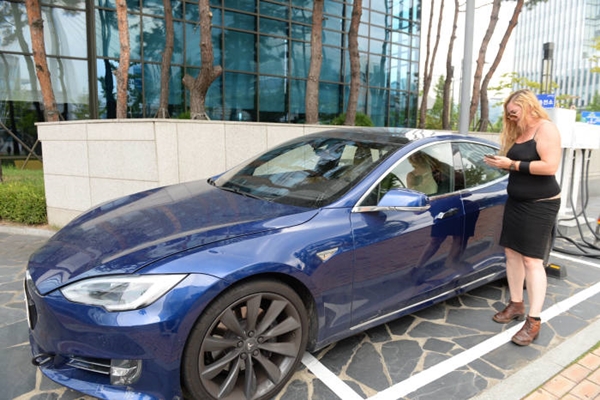Tesla has started test-driving its electric vehicle on roads in South Korea. It brought in a new electric vehicle that was released in the U.S. in April and is going to test-drive it on actual roads until the end of this month. Tesla is focusing on compatibility between its vehicles with current chargers that are installed at major branches and operated and testing of auto-pilot that is suitable for environment of roads in South Korea. Tesla is actively pushing to expand its business in South Korea by test-driving its models that are expected to be released, securing stores, and establishing its own charging facilities (super-charger).
It was confirmed that Tesla is carrying out test-drive of its electric vehicle called ‘Model S’ in an area in Pankyo on the 22nd. This scene was also caught by The Electronic Times’ cameras. Tesla’s employee that was riding this Tesla met with a reporter from The Electronic Times and said that this vehicle is only for test and that she came here to do some business.
A vehicle that was used for test-drive is called Model S P90D that was released in the U.S. in April and had blue color. A professional test driver from Tesla’s Headquarter is going to test drive it herself and examine compatibility and auto-pilot function that is Tesla’s self-driving function.
Because Tesla uses its own standards when its vehicles are charged slow or fast, separate adapters are used when its vehicles are not charged by its own charging stations called ‘super charger’. Tesla is going to connect its own adapters based on public charging infrastructures in Seoul and other metropolitan cities and check if they are working correctly.
Tests are going to be carried out through user certification that is carried out by South Korea’s charging service company’s membership card. CHAdeMO adapter and an adapter with J1772 (Type 1) standard are going to be used for rapid charging and slow charging respectively.

When it takes about 12 hours to charge Model S with a slow charger (7.7kWh), it takes less than 2 hours when a rapid charger is used. When faults are not noticed after testing Model S with charging, Tesla is going to provide corresponding adapter as an option or a bundle to South Korean buyers.
It seems that significant part of auto-pilot function’s software needs to be modified if it needs to be adjusted to South Korea’s road situation. Because auto-pilot function can adjust speed by utilizing changes in roads and active traffic cruise control, it needs to recognize roads right as a basic function. However there are some zigzag-type streets in South Korea, perfect recognition can be difficult for auto-pilot function. While Tesla is upgrading performance of its self-driving function, it is also checking regular simultaneous signals in South Korea.
“Tesla has been carrying out tests on charging and self-driving since last week and they are going to last for about 3 weeks.” said a representative for South Korea’s electric vehicle industry. “Not only is Tesla carrying out tests but it is also starting to select stores and other work with release of Model S P90D in schedule.”Model S P90D is an upgrade version and can drive up to 509km (based on calculation of European mileage) with just one charge. By having 90kWh lithium-ion battery and dual-motor (one for front wheel and rear wheel), its horsepower and torque are 532 horsepower and 98.8kg.m respectively. It is heard that it takes about 3 seconds for Model S P90D to reach 100km from a stand-still mode.
Staff Reporter Park, Taejun | gaius@etnews.com